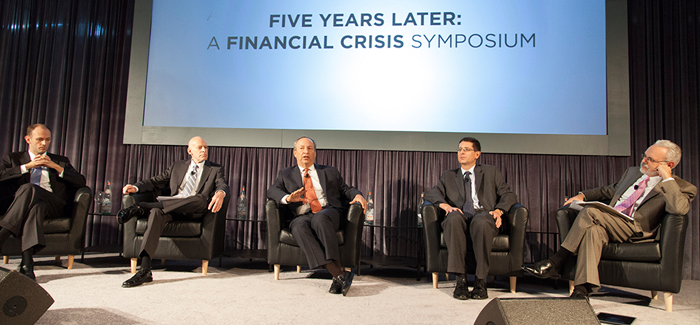
A bipartisan response to the 2008 crisis did not reconcile partisan disputes. (University of Chicago Institute of Politics)
Five years later, economic and political leaders assess the fallout from the 2008 financial crisis.
In some ways, the response to the financial crisis of 2008 was “a triumph of bipartisan cooperation,” said David Axelrod, AB’76, Institute of Politics director. Standing next to the former Obama adviser was Henry Paulson, who was treasury secretary in the Bush administration and now chairs the Paulson Institute, an independent think tank housed at the University. “When I take a five-year look back at the crisis,” Paulson agreed, “one of the things I’m most grateful for is that Republicans and Democrats came together to avert disaster.”
The two were introducing a daylong symposium they had organized to probe the causes and lessons of the crisis five years on. Held at the Spertus Institute in downtown Chicago and broadcast on C-SPAN, the October event brought together 18 political and financial leaders for five discussions moderated by prominent business journalists. About 250 people attended.
The symposium’s collegial welcome soon gave way to disagreement about the underlying economics of the crisis, much as bipartisan support for massive government intervention in 2008 devolved into fierce arguments over the bank bailout. In the first session Lawrence Summers, who directed the National Economic Council under President Obama, and Phillip Swagel, assistant secretary for economic policy at the Treasury Department under George W. Bush, clashed over whether regulators should have acted more aggressively to address systemic risks in the months leading up to the Lehman Brothers collapse.
“There are lots of things that I think many people in retrospect wish could have been done during that period,” Swagel said, but it wasn’t until after the crisis that Congress granted regulators the authority to wind down failing firms. Continued Summers, “Nobody had to go up to the Hill to tap institutions on the shoulder and say that their regulators were gravely concerned about their situation.” Swagel insisted that the message was delivered regularly leading up to the crisis. At the end of the session, neither had changed the other’s view about whether the warnings were delivered with sufficient force.
The opening panel also looked at postcrisis fiscal and monetary policy decisions, with Austan Goolsbee, the Chicago Booth economics professor who chaired the Council of Economic Advisers under Obama, and Edward Lazear, that council’s chair under Bush, taking opposing views. Goolsbee defended President Obama’s stimulus program as appropriately targeted given the political constraints. Lazear called it “a stopgap policy at best,” arguing that tax, regulatory, and trade reforms would have been more effective at restoring long-term growth. The pair also jostled over the Federal Reserve’s ongoing attempt to stimulate the economy by purchasing long-term assets. Goolsbee contended that economic conditions still call for such quantitative easing, against Lazear’s diagnosis that while it was “very effective” at first,“we’ve reached rapidly diminishing returns on this.”
Despite the furious wave of partisanship that surged across the country following the bank bailout, Democratic and Republican members on a panel discussing the postcrisis response agreed on the economic impact of the Troubled Asset Relief Program (TARP) vote. Former Massachusetts Democratic representative Barney Frank, coauthor of the landmark Dodd-Frank financial reform bill that emerged from the crisis, said, “TARP will go down in history as the most highly successful, wildly unpopular thing the federal government has ever done.” Neel Kashkari, a Republican and former assistant treasury secretary for financial stability, agreed that the bailout was essential to save the economy but added that injecting billions of dollars of taxpayers’ money to save firms and individuals who had taken irresponsible risks violated a fundamental American belief in fairness. “The fact that Congress is so polarized today, I think, is actually a result of the actions we had to take in 2008,” he said.
Fewer than half of the financial reforms articulated in the Dodd-Frank bill have been implemented. But “getting it right is more important than getting it quick,” as the bill’s coauthor, former Connecticut Democratic senator Chris Dodd, pointed out with regard to the long-delayed Volcker Rule, which prohibits banks from trading for profit. Other regulatory changes—including transparency in the derivatives market and establishment of the Consumer Financial Protection Bureau—are already having an effect. More enforcement and stiffer penalties are “driving the industry to a much more deeply embedded focus on risk management,” said Mary Schapiro, who chaired the Securities and Exchange Commission from 2009 to 2012.
The country remains vulnerable to serious risks, a panel of financial experts agreed. Morgan Stanley CFO Ruth Porat said the public/private student loan industry “looks frighteningly like it could be the next Fannie/Freddie.” BlackRock Investments chair and CEO Laurence Fink cited worrisome technological glitches and lack of oversight in the exchanges on which investors are increasingly relying. And Frederick Waddell, chair and CEO of Northern Trust, described underfunded public pension funds as “a ticking time bomb.”
“None of us ever want to have our nation go through another crisis like the 2008 crisis,” Paulson said at the symposium’s outset. Unfortunately the prospects for bipartisan cooperation have significantly dimmed over the past five years. The day’s discussions suggested that competing views on the economics and politics surrounding the crisis have not been reconciled. If anything, they look even more entrenched.
